How to Prevent Mold in a Midwestern Home
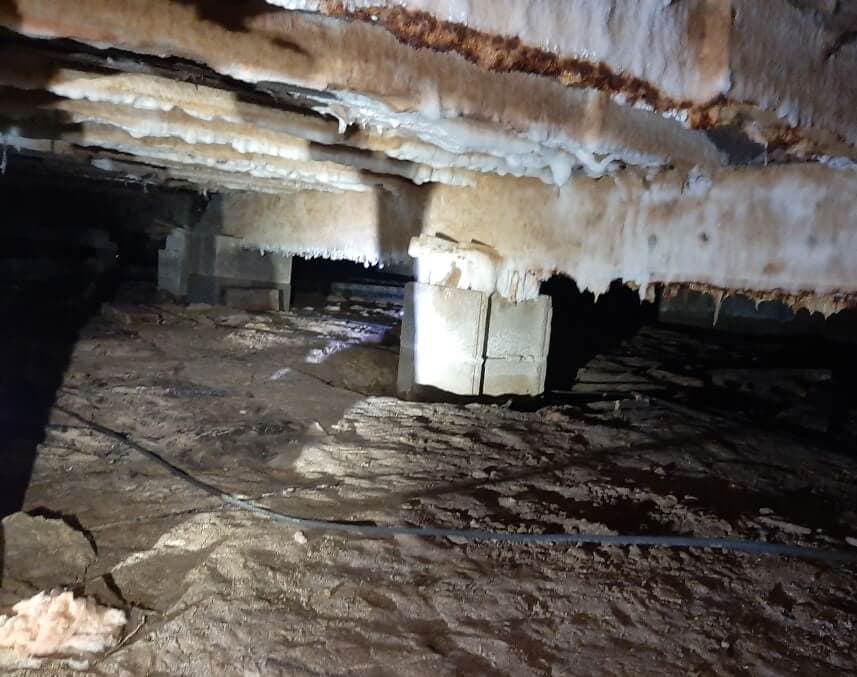
No homeowner wants to see mold growth in their home. It doesn’t matter if it’s on leftovers in your fridge, the bathroom grout, or on your basement wall — mold is not a welcome addition to anyone’s home!
In the Midwest, we cope with subzero temperatures in the winter and suffer through sweltering 90°+ days in the summer. These extremes are just part of our day-to-day existence and we have learned to be adaptable. Our homes are not quite as flexible, which means we have to make modifications to our homes to compensate for these considerable climate fluctuations.
Acculevel is an Indiana-based contractor that specializes in foundation repair and waterproofing. Since our start in 1996, we’ve helped more than 35,000 homeowners preserve and protect their greatest investment. As a family-owned and operated company, our first priority is the health and safety of our customers and their homes.
In this article, we’re going to explore what causes mold to grow, how to treat mold if you have any in your home, and how to prevent mold from occurring or returning.
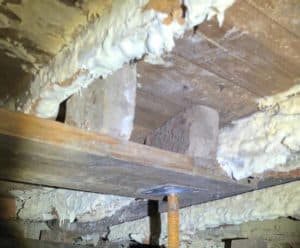 This photo was taken by an Acculevel project advisor during a routine home assessment. The floor joists and beams in this crawl space are damp, decaying, and covered in mold.
This photo was taken by an Acculevel project advisor during a routine home assessment. The floor joists and beams in this crawl space are damp, decaying, and covered in mold.
Mold is Everywhere and Can Thrive Anywhere
Mold is a type of plant life, and it’s extremely diverse and hardy. We frequently use the broader term “biological growth” when describing mold since this can encompass mildew, fungus, viruses, and bacteria.
Mold spores can be carried through the air, tracked in on your shoes, or arrive with your teenager’s nasty gym clothes which are currently shoved under the bed instead of placed in the laundry basket. Germs, microbes, and other biological growth are the same way — they’re ubiquitous and unavoidable.
In fact, research from 2008 found that out of 831 residential homes across the U.S., 24% of surveyed homes had some sort of moisture or mold problem.
All it takes to feed these nasty little life forms is a source of food and moisture, making mold prevention a challenge. Food sources are easy to find in your home: dust, shedded skin cells, or any other natural or organic matter that has simple starches or sugars. Some bacteria can even photosynthesize like house plants! So there’s really no way to eliminate their food source, unless you can manage a 100% sterile environment (which would not allow for humans).
That leaves us with the other option: controlling the excess moisture in your home.
What Causes Mold Growth in a Basement or Crawl Space?
Mold and related biological growth thrive in areas with damp or humid air. Please notice that we didn’t say anything about standing water or a space needing to be wet. All microbes like bacteria or mildew need is moisture.
Moisture is easy to find in your home’s foundation. Concrete, brick, and stone are all porous building materials, which means they can absorb water and allow mold growth. At the height of a Midwestern summer, condensation naturally occurs in basements and crawl spaces. The temperature difference between the hot air outside and the cold surfaces inside your foundation creates this moisture problem.
Signs You Have Moisture Problems
If you’re inspecting your basement or crawl space during a cold or especially dry season, you may not see or feel any dampness. But you could still have evidence of water damage or high moisture levels If you have efflorescence on your walls.
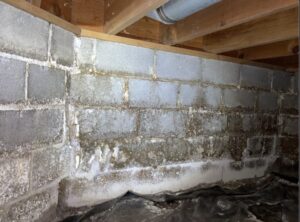
This photo was taken by an Acculevel project advisor, during a routine home evaluation. You can clearly see white mineral deposits on the crawl space wall.
Efflorescence is the scientific way of describing the residue left behind after water intrusion has occurred. When water seeps through a surface, then dries, it leaves behind traces of minerals like salt. These usually feel coarse to the touch and can be other colors than white. If you live in an area with hard water, the efflorescence you find could be rust-colored.
Why Is Mold Prevention So Important?
If you’re reading an article on how to prevent mold, you probably know the answer to this question. This is especially true if you or someone in your family has allergies, asthma, or other respiratory issues. Even people with healthy immune systems and no prior allergies can develop a serious medical problem with long-term exposure. Infants, children, and the elderly are at a higher risk for health complications. This makes mold prevention a top priority for most homeowners.
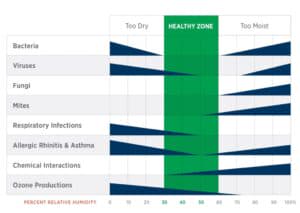
This chart is the result of a study done by ASHRAE (American Society of Heating, Refrigerating, and Air-Conditioning Engineers). It gives a review of the different types of harmful organisms that can thrive in our homes, as well as their ideal growing conditions.
Mold is not the only threat to your family that thrives in a moist environment. If you look at the chart above, you can see a list of threats to your health. None of us want these intruders in our air.
A Dehumidifier Controls Moisture Levels
We recommend that you invest in a whole-home dehumidifier, one that is capable of restricting the humidity levels of your entire home. These are more expensive than the small portable ones you can find at a box store.
Why Don’t We Recommend Portable Dehumidifiers?
These are not meant to regulate the indoor humidity of your entire home — making them a bad tool for managing mold growth prevention in the home. They’re designed to minimize moisture within limited square footage. They also don’t usually provide you with the added comfort of selecting the desired humidity level.
What is worse is that many people will use a portable dehumidifier to regulate a larger area than it’s designed to manage. This means that the dehumidifier will run at maximum capacity all the time. Home appliances aren’t designed to work this hard for that long. This will certainly shorten its lifespan and possibly even become a fire hazard. In the last 10 years, approximately 8 million portable dehumidifiers have been recalled.
Why Do We Recommend Whole-Home Dehumidifiers?
As the name suggests, this is an appliance that is designed to control the indoor humidity of your entire home. They’re generally installed next to a sump pump, so they can drain automatically as needed. These models also should include controls that allow you to select a specific humidity level and maintain it. As we learned in the previous section, the ideal level for preventing mold and disease control is around 50%.
Keep in mind that having central air conditioning does not replace the need for a dehumidifier. Yes, an HVAC system does include a filter, but it’s designed to circulate air and control the temperature of that air — not remove humidity from it. In fact, using an efficient whole-home dehumidifier can actually make your HVAC system run better and at a more cost-effective rate. Drier air is easier to cool and lower humidity levels can make your home feel more comfortable.
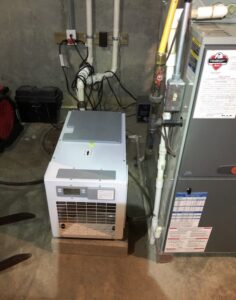
This photo was taken by an Acculevel team member, after waterproofing a basement and installing a sump pump and a dehumidifier.
How Can You Prevent Mold Growth?
The best way to prevent mold is to keep your basement or crawl space dry. This is one of those tasks that’s easier to say than to do. As we’ve discussed, biological organisms don’t need standing water to grow; just a bit of moisture is enough.
DIY Projects That Can Improve a Humid Area
Some home projects or upgrades are best left to a professional, but there are things you can do yourself to improve your home’s overall health:
- Perform seasonal inspections. We recommend that you inspect your home at least twice per year, usually in spring and fall. You’re looking for cracks, decay, efflorescence, etc. You can get our free DIY Foundation Inspection Guide here.
- Insulate Water Lines. This is particularly important for cold water pipes because condensation often forms on these.
- Fix water leaks. This one is a bit obvious, but fix any dripping pipes or water lines promptly. Make sure you completely dry out the affected space and remove excess moisture.
- Don’t store outside items in your basement. While it may be convenient to keep some extra firewood inside your home, this can lead to multiple problems. Not only is wood a porous material that holds onto moisture, but it could also be harboring harmful insects or hidden mold spores. The same is true for extra potting soil, planters that contain dead plant materials, etc.
- Clean your gutters and extend downspouts. We recommend that your guttering drains at least 10 feet away from your foundation. Excess water in the soil around your home significantly increases your risks of water damage —and not just water intrusion. Water is the primary cause of foundation cracks, erosion that causes settling, and even bowing or leaning walls.

Waterproofing Your Home
If you’re struggling with more than just high humidity — especially if you have any form of water intrusion or leaks —you need waterproofing in addition to a dehumidifier. This is a water management system that includes interior water drainage and a sump pump. These systems are designed to direct any water that gets into your home to the pump, which expels it out of your home to drain a safe distance away from your foundation.
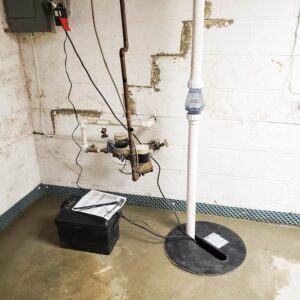
This photo was taken by an Acculevel team member after waterproofing a basement. We install a type of sump pump that includes a battery back-up.
Because there are so many options and facets to this topic, it really needs to be covered on its own. We encourage you to bookmark and read one of our waterproofing guides once you’ve learned what you need about mold growth and prevention!
All of our homeowner guides are free, detailed, and comprehensive reviews that cover installation types, methods, costs, and necessary repairs.
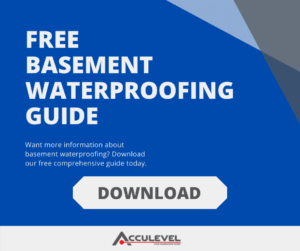 |  |
Encapsulation is an Excellent Option
The best possible way to prevent biological growth and improve your air quality is through encapsulation. Encapsulation is the process of lining walls (and floors in crawl spaces) with a specialized material. At Acculevel, we use a liner made of woven resin polyethylene. This liner is the strongest and most puncture-resistant material available to contractors. It’s also inorganic, which means it will not support any biological growth.

This photo was taken by an Acculevel crew member after waterproofing and encapsulation.
We recommend encapsulation for all of our customers, but it is especially valuable to homeowners in the following situations:
- Your home has a foundation made of brick or stone; these are more susceptible to water intrusion than concrete.
- Water intrusion is a common or frequent occurrence. This is common in areas with a high water table (you live near a body of water like a lake, river, creek, etc).
- You plan to finish your basement. No one wants to invest time and money into building out a living area only to rip it all out when moisture leads to mold growing on the insulation or drywall.
- Someone in your household has strong allergies, asthma, a compromised immune system, a chronic respiratory condition, or any health condition that reduces their immunity to viruses and bacteria.
How Do You Safely Remove Mold?
To begin with, you should not remove it. Unless you have the necessary experience, materials, and protective gear, it’s best to leave removal to the professionals. The EPA recommends that if the mold covers more than 10 square feet, you should work with a pro. This is especially true for any mold growth that requires scraping. Scraping mold doesn’t just remove it — it also can release additional mold spores if not done correctly.

This photo was taken by an Acculevel project advisor during a free in-home assessment. The mold growing on these floor joists will need to be scraped off before treatment can be applied.
A professional will be able to safely assess the severity of the problem, determine the needed solution(s), and perform the work without putting you or your family at risk. You can learn more about Acculevel’s mold-killing products and treatment methods for mold, mildew, and other biological growth here.
Are You Ready to Meet with an Acculevel Pro?
While you might have some of the knowledge needed to understand how to prevent mold, you don’t have to go it all alone. With the help of an expert team, you can manage mold prevention with ease.
If you live in Indiana or within our service area, give us a call at 866-669-3349. Prefer electronic communication? Complete our online form and one of our friendly call center representatives will schedule an in-home meeting with an experienced project advisor in your area.
They will address all your concerns about your home, review what you want to be updated or changed, and then assess your house for potential issues. Together, we’ll develop a whole-home solution for resolving all your mold prevention problems and create a plan to protect your home from future damages.
